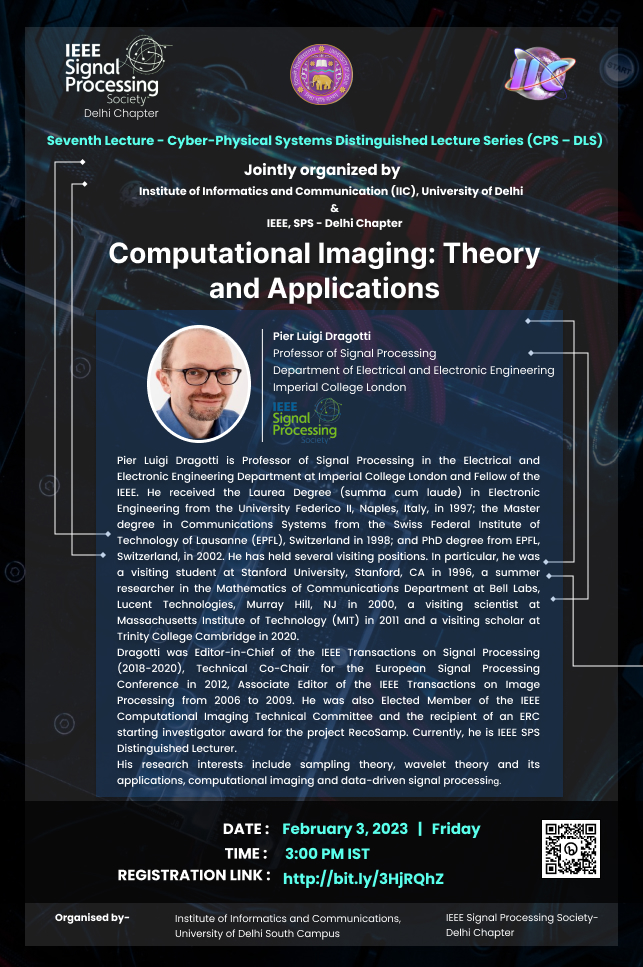The Institute of Informatics and Communication (IIC), University of Delhi, jointly with the IEEE Signal Processing Society-Delhi chapter, has started a Cyber Physical Systems Distinguished Lecture Series (CPS – DLS) beginning March 2022. IEEE Delhi chapter and IIC have been very active in organizing webinars with the help of international experts of diverse disciplines.
The seventh lecture of this series is scheduled for February 3, 2023 and will be delivered by Pier Luigi Dragotti, Professor, Department of Electrical and Electronic Engineering, Imperial College, London, UK.

Pier Luigi Dragotti is a Professor of Signal Processing in the Department of Electrical and Electronic Engineering, Imperial College, London and a Fellow of IEEE. He received Laurea Degree (summa cum laude) in Electronic Engineering from the University Federico II, Naples, Italy, in 1997; Master degree in Communication Systems from Swiss Federal Institute of Technology of Lausanne (EPFL), Switzerland in 1998; and PhD degree from EPFL, Switzerland, in 2002. He has held several visiting positions as well. In particular, he was a visiting student at Stanford University, Stanford, CA in 1996, a summer researcher in the Department of Mathematics of Communication at Bell Labs, Lucent Technologies, Murray Hill, NJ in 2000, visiting scientist at Massachusetts Institute of Technology (MIT) in 2011 and visiting scholar at Trinity College Cambridge in 2020. Dragotti was Editor-in-Chief of the IEEE Transactions on Signal Processing (2018-2020), Technical Co-Chair for the European Signal Processing Conference in 2012, Associate Editor of the IEEE Transactions on Image Processing from 2006 to 2009. He was also an Elected Member of the IEEE Computational Imaging Technical Committee and recipient of an ERC starting investigator award for the project RecoSamp. Currently, he is IEEE SPS Distinguished Lecturer. His research interests include sampling theory, wavelet theory and its applications, computational imaging and data-driven signal processing.
The revolution in sensing, with the emergence of many new imaging techniques, offers the possibility of gaining unprecedented access to the physical world, but this revolution can only bear fruit through the skilful interplay between the physical and computational realms. This is the domain of computational imaging which advocates that, to develop effective imaging systems, we need to rethink imaging as an integrated sensing and inference model.
In the first part of the talk we highlight the centrality of sampling theory in computational imaging and investigate new sampling modalities which are inspired by the emergence of new sensing mechanisms. We discuss time-based sampling which is connected to event-driven cameras where pixels behave like neurons and fire when an event happens. We derive sufficient conditions and propose novel algorithms for the perfect reconstruction of classes of non-bandlimited functions from time-based samples. These results inspires the design of deep neural networks for the reconstruction of intensity videos from events.In the second part of the talk, we develop the interplay between learning and computational imaging. We discuss the problem of monitoring the activity of neurons with two-photon microscopes and present a model-based neural network for the localization of neurons. The architecture of the network is model-based and is designed using the unfolding technique. Finally, we focus on the heritage sector which is experiencing a digital revolution driven in part by the increasing use of non-invasive, non-destructive imaging techniques. These new imaging methods provide a way to capture information about an entire painting and can give us information about features at or below the surface of the painting. We focus on Macro X-Ray Fluorescence (XRF) scanning which is a technique for the mapping of chemical elements in paintings and introduce a method that can process XRF scanning data from paintings. The results presented show the ability of our method to detect and separate weak signals related to hidden chemical elements in the paintings. We analyse the results of Leonardo’s “The Virgin of the Rocks” and show that our algorithm is able to reveal, more clearly than ever before, the hidden drawings of a previous composition that Leonardo then abandoned for the painting that we can now see.
Kindly make the best use of this event to enhance your knowledge on this subject.